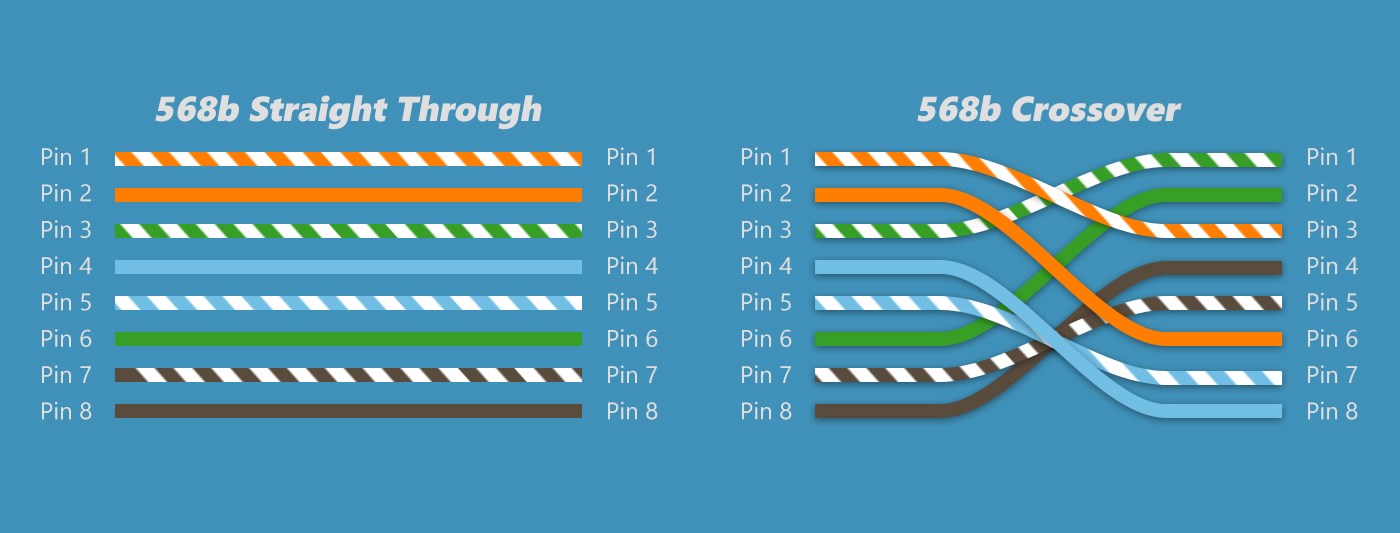Resistor Color Codes

Example: Red,Red,Red would be 2200 ohms.

Example: Red,Red,Red would be 2200 ohms.
TIA/EIA-568-B.1-2001:
is likely the most commonly used and talked about feature of the specification created in 1988.
568-a is the definition of pin assignments for the the pairs within Category 3 (CAT3), Category 5 (CAT5) and Category 6 (CAT6),
unshielded twisted-pair (UTP) cables (eight conductor, 100-ohm balanced twisted pair cabling).
The Pin/Pair assignments were named T568A and T568b, both of which define the pinout or specific order the UTP pairs need to be terminated within 8P8C
(Eight Position, Eight Conductor) modular connectors, also known as RJ45 connectors.
| Pin # | Wire Color | Pin # | Wire Color |
|---|---|---|---|
| 1 | White/Green | 1 | White/Orange |
| 2 | Green | 2 | Orange |
| 3 | White/Orange | 3 | White/Green |
| 4 | Blue | 4 | Blue |
| 5 | White/Blue | 5 | White/Blue |
| 6 | Orange | 6 | Green |
| 7 | White/Brown | 7 | White/Brown |
| 8 | Brown | 8 | Brown |
An Ethernet crossover cable
is a network cable used to connect two Ethernet network devices directly such as two computers without a switch or router in between.
They are used to send and receive data by enabling complex data transfers between computers, routers, and networks.
Ethernet crossover cables are similar to straight-through cable except that they have pairs of wires that crisscross.
Their internal wiring reverses the incoming and outgoing signals and uses a design that allows the data output pins on one
end of the cable to be connected directly to the data input pins on the other end of the cable.
These two types of Ethernet cables are commonly used in most computer networking transmissions.
A straight-through cable is used in local area networks to connect different devices like a computer to a network hub such as a router, router and switch, PC and switch and so on.
It is an alternative to wireless connections where one or more computers access a router through a wireless signal.
A crossover cable is only required when interconnecting two devices with the same functionality.

Another significant difference between crossover cables and normal patch cables is that each type will have different wire arrangement in the cable for serving different purposes.
If you hold up both ends of the cable and compare the pin-outs, you will note that the straight-through cable has matching wired pins while a crossover cable has pins that are typically reversed.
There are two standards for wiring Ethernet cables as recognized by ANSI, TIA and EIA. One is the T568A wiring standard, and the other is T568B.
The difference between the two is the position of the orange and green wire pairs. Straight-through cables have a one wiring standard where both ends use T568A wiring standard, or both ends use T568B wiring standard.
Unlike straight-through cables, crossover cables use two different wiring standards. One end uses the T568A wiring standard while the other end uses the T568B wiring standard.
Usually, the crossover cable has the words Crossover or Xover printed on it to distinguish it from straight-through ones.
Functionality Difference between Straight Cable and Cross Cable
Crossover cables are used when:
Connecting a computer to a computer
Connecting a router to a router
Connecting a switch to a switch
Connecting a hub to a hub and
Connecting a router to a PC because both devices have the same components

On the other hand, straight-through cables are used when:
Connecting a router to a hub
Connecting a computer to a switch
Connecting a LAN Port to a switch or computer
Connecting other dissimilar networking equipment
While in the past a crossover cable was required to connect two host devices directly, it is no longer necessary.
Many modern network devices support Auto MDI-X, which automatically detects the proper connection type no matter which cable you use.
For example, a computer with Auto MDI-X can use either a straight-through or crossover cable for any application.